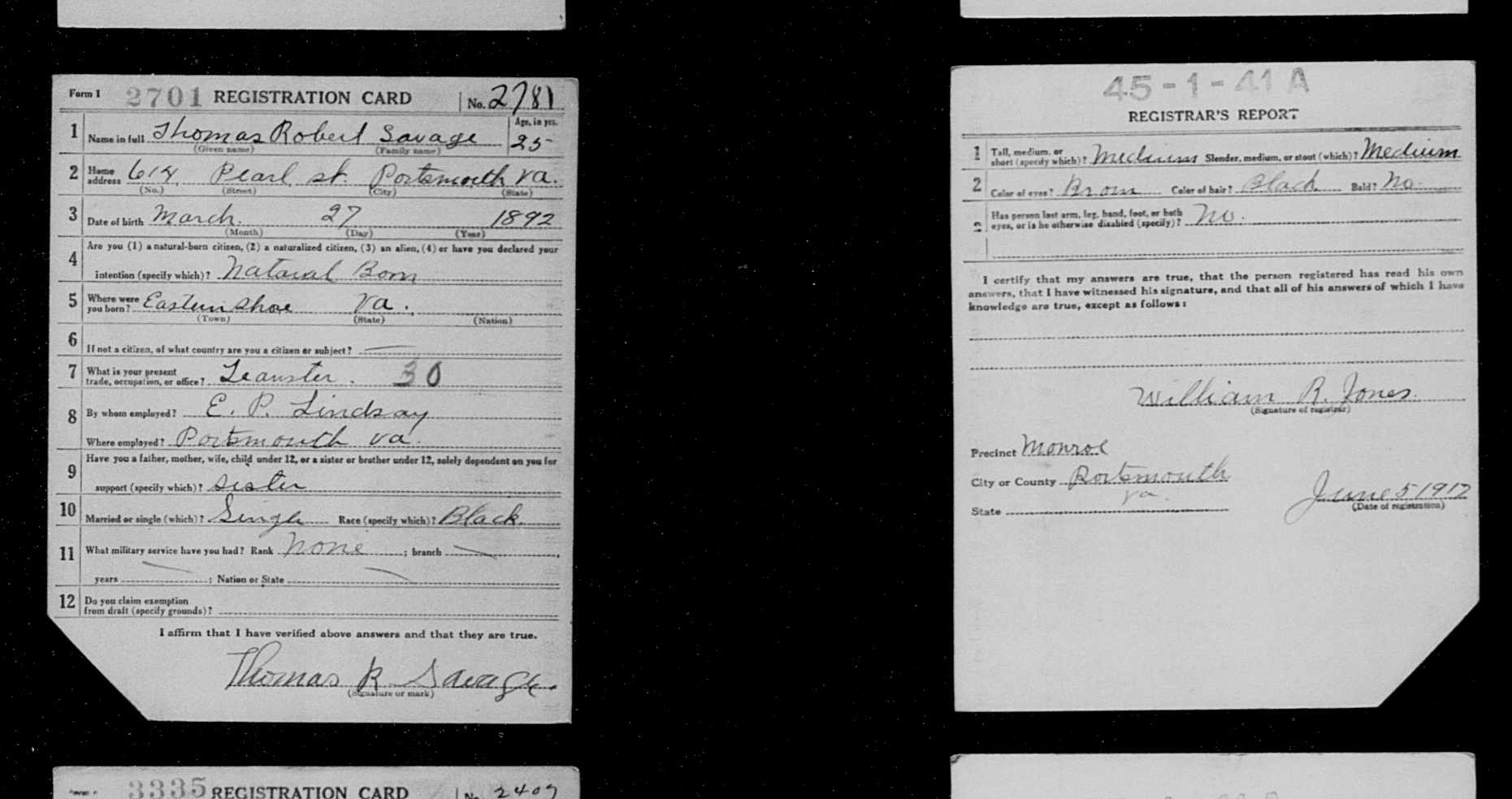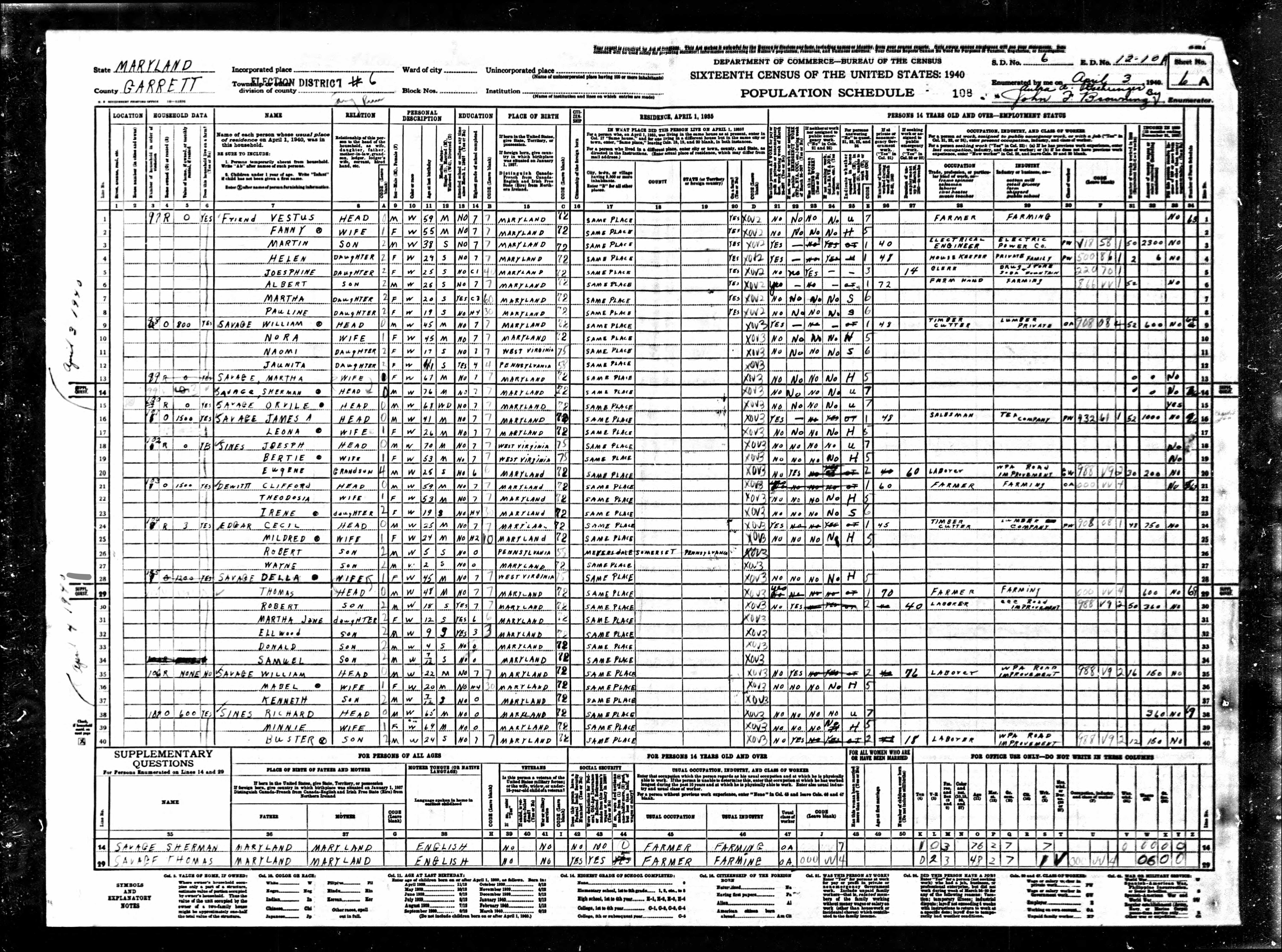Thomas Robert Savage (March 17, 1892–April 7, 1941)
By Harrison Smith
Early Life
Thomas Robert Savage was born on March 17, 1892, in Eastern Shore, Virginia.1 Much of Savage’s early life is unknown; it is uncertain if he attended school, but he did know how to read and write.2 It is almost certain that he resided in Virginia when the Selective Service Act of 1917 was passed.
Military Service
After Congress passed the Selective Service Act, all men aged twenty-one to thirty-one had to register for the draft on June 5, 1917. As pictured here, Savage was twenty-five years old, single and living in Portsmouth, Virginia.3 Savage registered in Portsmouth, Virginia on June 5, 1917. We cannot be certain where, but Thomas Robert Savage was inducted on August 3, 1918.4 By this time, Savage had married Della Luecress Bennett.5
After being inducted into the Army, Savage was assigned to Company C of 540th Engineers Service Battalion6 and more than likely trained at Camp Humphreys, Virginia. After a little over two months of training, the battalion would travel to New Jersey to await passage to France. Savage and his company departed from Hoboken, New Jersey, on October 27, 1918 aboard the S.S. Leviathan.7 The Leviathan was a recently captured German ship originally named the Vaterland. The journey to France was not an easy one; most vessels were in transit from ten days to three weeks. The time spent at sea mainly depended on weather conditions; however, possible attacks from German U-Boats around the English-channel also caused delays.
During World War I, most African Americans served in non-combatant units used for manual labor. Many white officials were frightened of African Americans learning to operate and carry firearms. So, the vast majority of African Americans served as engineers, pioneers, and in supply units. Upon arrival in France, Savage and his company constructed trenches, bridges, and roads that allowed the Army to push forward against the enemy. Luckily for Savage and his company, they were spared most of the brutality of the war, since the Armistice was signed on November 11, 1918, shortly after their arrival . However, Savage now had to wait to return home to Virginia and to his wife, Della. On May 21, 1919, Savage and his company would depart France aboard the S.S. Britannia and arrive in Brooklyn, New York, on June 6, 1919.8 Savage had risen to the rank of Corporal before he was honorably discharged on June 18, 1919.9
Post-Service Life
After leaving the military, Savage traveled back home to his wife in Portsmouth, Virginia. In 1920, Della and Thomas were stilled married and lived at the same residence, Savage was working as a driver.10 By 1940, the couple had moved to a farm in Garrett County, Maryland, and their combined income was about 960 dollars.11 The couple also started a family together, shown here, they had five children, Robert (18), Martha Jane (12), Ellwood (9), Donald (4), and Samuel (7 months).12 Unfortunately, Thomas Robert Savage died April 7, 1941 leaving behind his wife and children behind.13 Savage was buried in St. Augustine National Cemetery and is located in Section D, Grave 3.14 He was forty-nine years old.
Endnotes
1 “United States World War I Draft Registration Cards, 1917-1919,” database, Familysearch (https://familysearch.org: accessed July 10, 2018), entry for Thomas Robert Savage.
2 “Virginia, Portsmouth, Portsmouth Monroe Ward, District 0178, 1920 United States Federal Census,” database, Ancestry (https://ancestry.com: accessed July 10, 2018) entry for Thomas Robert Savage.
3 “United States World War I Draft Registration Cards, 1917-1919,” database, Familysearch (https://familysearch.org: accessed July 10, 2018), entry for Thomas Robert Savage.
4 “U.S. National Cemetery Interment Control Forms, 1928-1962,” database, Ancestry (https://ancestry.com: accessed July 10, 2018), entry for Thomas Robert Savage.
5 “U.S., Army Transport Service, Passenger Lists, 1910-1939,” database, Ancestry (https://ancestry.com: accessed July 10, 2018), entry for Thomas Robert Savage
6 “U.S., Army Transport Service, Passenger Lists, 1910-1939,” database, Ancestry (https://ancestry.com: accessed July 10, 2018), entry for Thomas Robert Savage.
7 “U.S., Army Transport Service, Passenger Lists, 1910-1939,” database, Ancestry (https://ancestry.com: accessed July 10, 2018), entry for Thomas Robert Savage
8 “U.S., Army Transport Service, Passenger Lists, 1910-1939,” database, Ancestry (https://ancestry.com: accessed July 10, 2018), entry for Thomas Robert Savage
9 “U.S. National Cemetery Interment Control Forms, 1928-1962,” database, Ancestry (https://ancestry.com: accessed July 10, 2018), entry for Thomas Robert Savage
10 “Virginia, Portsmouth, Portsmouth Monroe Ward, District 0178, 1920 United States Federal Census,” database, Ancestry (https://ancestry.com: accessed July 10, 2018) entry for Thomas Robert Savage
11 “Maryland, Garrett, Other Places, 12-10A, 1940 United States Federal Census,” database, Ancestry (https://ancestry.com: accessed July 10, 2018) entry for Thomas Robert Savage
12 “Maryland, Garrett, Other Places, 12-10A, 1940 United States Federal Census,” database, Ancestry (https://ancestry.com: accessed July 10, 2018) entry for Thomas Robert Savage
13 “U.S. National Cemetery Interment Control Forms, 1928-1962,” database, Ancestry (https://ancestry.com: accessed July 10, 2018), entry for Thomas Robert Savage
14 “U.S. National Cemetery Interment Control Forms, 1928-1962,” database, Ancestry (https://ancestry.com: accessed July 10, 2018), entry for Thomas Robert Savage
© 2018, University of Central Florida




